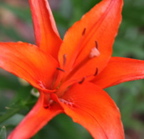heres info on Astaxanthin:
Algae is normally green unless it is subjected to stressors like UV light from the sun. It produces astaxanthin, a member of the deeply pigmented carotenoid family, like lutein and lycopene, to protect itself from environmental challenges. It is this compound that makes salmon, shrimp or lobster pink in color. Astaxanthin works in a similar way to protect human skin from environmental damage by building up under the skin as a protective shield.
Clinical studies show that astaxanthin may be effective therapy for cardiovascular health, an anti-inflammatory and an immune system builder. It is truly a super-antioxidant because it is 100-500 times stronger than vitamin E, and actually assists the action of vitamin E and C in their antioxidant activity.
Astaxanthin and Other Health Properties
What are other potential benefits of astaxanthin on health and wellness?
It is clear that astaxanthin is a potent carotenoid and, at least in some farmed animals, it provides demonstrable health benefits. Astaxanthin has further been shown to exhibit potential health benefits in numerous tests using laboratory animals. These results offer some indication that astaxanthin may be useful in the maintenance of human health, to the extent that these animal test results can be extrapolated to human beings.
Several studies have shown the effectiveness of astaxanthin as a cancer preventive in rats and mice. For example, Tanaka et al. (1994b) showed that astaxanthin protected mice from urinary bladder carcinogenesis. The investigators fed a known bladder carcinogen to two groups of mice (36 and 33 mice respectively) for 20 weeks. Then, the carcinogen was removed from the diet for both groups. After another week, the second group of mice was fed astaxanthin in the diet for another 20 weeks while the first group did not get any astaxanthin. Histological examination of the mouse bladders indicated that while the group that did not get astaxanthin showed a 42% incidence of bladder carcinoma the astaxanthin group had only an 18% incidence rate. In a second study (Tanaka et al. 1995b) the investigators showed that astaxanthin prevents oral carcinogenesis in rats. The investigators fed a known carcinogen to a group of rats. A second group of the rats was also fed the carcinogen but supplemented with astaxanthin. In this direct comparison they found that the group fed both the carcinogen and astaxanthin had a significantly lower incidence of different types of cancerous growths in their mouths than those rats fed only the carcinogen. The authors concluded that astaxanthin offered effective protection against oral cancer. They also concluded that the inhibitory effect of astaxanthin on cancer was even more pronounced than that of beta-carotene, which they had tested in a previous study (Tanaka et al. 1994a). A further study by this group (Tanaka et al. 1995a) explored the effect of astaxanthin on colon cancer in male rats. As in the previous studies, groups of rats were fed a known colon carcinogen with or without astaxanthin supplements in the diet. Again, the investigators found a significant (P<0.001) decrease in the incidence of colon cancer in those animals that were given astaxanthin.
Astaxanthin has been shown to significantly influence immune function in a number of in vitro and in vivo assays using animal models. The majority of this work has been carried out by Harumi Jyonouchi and colleagues at the University of Minnesota. Astaxanthin enhances in vitro antibody production by mouse spleen cells stimulated with sheep red blood cells (Jyonouchi et al. 1991), at least in part by exerting actions on T-cells, especially T-helper cells (Jyonouchi et al. 1993). Astaxanthin can also partially restore decreased humoral immune responses in old mice (Jyonouchi et al. 1994). These immunomodulating properties are not related to provitamin-A activity, because astaxanthin, unlike beta-carotene, does not have such activity (Jyonouchi et al. 1991). Studies on human blood cells in vitro have demonstrated enhancement by astaxanthin of immunoglobulin production in response to T-dependent stimuli (Jyonouchi et al. 1995a). Other supporting data on astaxanthin and immune function, including studies on the mechanisms of action involved, may be found in Jyonouchi et al. (1995b), Jyonouchi et al. (1996), Okai & Higashi-Okai (1996), and Tomita et al. (1993).
There is abundant evidence that certain carotenoids can help protect the retina from oxidative damage (Snodderly 1995). A recent study with rats indicates that astaxanthin is effective at ameliorating retinal injury, and that it is also effective at protecting photoreceptors from degeneration (Tso and Lam 1996). The results of this study suggest that astaxanthin could be useful for prevention and treatment of neuronal damage associated with age-related macular degeneration, and that it may also be effective at treating ischemic reperfusion injury, Alzheimer's disease, Parkinson's disease, spinal cord injuries, and other types of central nervous system injuries (Tso and Lam 1996). In this study, astaxanthin was found to easily cross the blood-brain barrier (unlike beta-carotene), and did not form crystals in the eye (unlike canthaxanthin; Tso and Lam 1996).
Top of page
References:
Jyonouchi H., Hill R. J., Tomita Y., and Good R. A. (1991) Studies of immunomodulating actions of carotenoids. I. Effects of ß-carotene and astaxanthin on murine lymphocyte functions and cell surface marker expression in in vitro culture system. Nutr. Cancer, 16(2):93-105.
Jyonouchi H., Sun S., and Gross M. (1995) Effect of carotenoids on in vitro immunoglobulin production by human peripheral blood mononuclear cells: astaxanthin, a carotenoid without vitamin A activity, enhances in vitro immunoglobulin production in response to a T-dependent stimulant and antigen. Nutr. Cancer, 23(2):171-183.
Jyonouchi H., Sun S., Mizokami M., and Gross M. D. (1996) Effects of various carotenoids on cloned, effector-stage T-helper cell activity. Nutr. Cancer, 26(3):313-324.
Jyonouchi H., Sun S., Tomita Y., and Gross M. D. (1995) Astaxanthin, a carotenoid without vitamin A activity, augments antibody responses in cultures including T-helper cell clones and suboptimal doses of antigen. J. Nutr., 125(10):2483-2492.
Jyonouchi H., Zhang L., and Tomita Y. (1993) Studies of immunomodulating actions of carotenoids. II. Astaxanthin enhances in vitro antibody production to T-dependent antigens without facilitating polyclonal B-cell activation. Nutr. Cancer, 19(3):269-280.
Jyonouchi H., Zhang L., Gross M., and Tomita Y. (1994) Immunomodulating actions of carotenoids: enhancement of in vivo and in vitro antibody production to T-dependent antigens. Nutr. Cancer, 21(1):47-58.
Okai, Y., and K. Higashi-Okai. (1996) Possible immunomodulating activities of carotenoids in in vitro cell culture experiments. Int. J. Immunopharmacol., 18:753-758.
Snodderly, D.M. (1995) Evidence for protection against age-related macular degeneration by carotenoids and antioxidant vitamins. Am. J. Clin. Nutr., 62(suppl):1448S-1461S.
Tanaka, T., Morishita, Y., Suzui, M., Kojima, T., Okomura, A., and Mori, H. (1994b) Chemoprevention of mouse urinary bladder carcinogenesis by the naturally occurring carotenoid astaxanthin. Carcinogen., 15:15-19.
Tanaka, T., Makita, H., Ohnishi, M., Hirose, Y., Wang, A., Sato, K., Hara, A., and Ogawa, H. (1994a) Chemoprevention of 4-nitroquinoline-1-oxide-induced oral carcinogenesis by dietary curcumin and hesperidin: comparison with the protective effect of ß-carotene. Cancer Res., 54:4653-4659.
Tanaka, T. Kawamori, T., Ohnishi, M., Makita, H., Mori, H., Satoh, K., and Hara, A. (1995a) Suppression of azoxymethane-induced rat colon carcinogenesis by dietary administration of naturally occurring xanthophylls astaxanthin and canthaxanthin during post initiation phase. Carcinogen., 16:2957-12963.
Tanaka, T., Makita, H., Ohnishi, M., Hideki, M., Sato, K., and Hara, A. (1995b) Chemoprevention of rat oral carcinogenesis by naturally occurring xanthophylls, astaxanthin and canthaxanthin. Cancer Res., 55:4059-4064.
Tomita Y., Jyonouchi H., Engelman R. W., Day N. K., and Good R. A. (1993) Preventive action of carotenoids on the development of lymphadenopathy and proteinuria in MRL-lpr/lpr mice. Autoimmunity 16:95-102.
Tso, M. O., and T.-T. Lam. (1996) Method of retarding and ameliorating central nervous system and eye damage, U.S. Patent #5527533. Board of trustees of the University of Illinois, United States of
















































